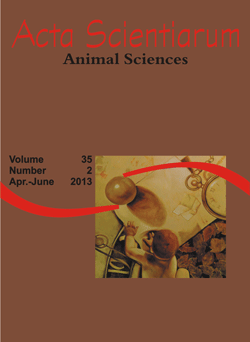<b>Breed and selection line differences in the temperament of beef cattle</b> - doi: 10.4025/actascianimsci.v35i2.16426
Keywords:
beef cows, behavior, fear, husbandry
Abstract
The temperament of four beef cattle breeds were measured using a flight time test (FT) and a behavior score test (BST). FT was defined as the time taken by animals to cross a distance of 2 m after weight scale. The BST used a visual assessment of cattle behavior in which the results of four categories defined the score: movements, breathing intensity, vocalization and kicking. FT and BST coefficients of heritability were estimated using the restricted maximum likelihood, considering half siblings. Caracu presented a lower BST value than the other breeds. Nellore presented intermediate results, followed by Guzerat and Gyr with similar and higher means (p < 0.05). Similar results were observed with FT, but Caracu and Nellore did not differ from each other. A low association between FT and BST was found (rp= -0.36; p < 0.01). The correlation between a sire’s ranking, according to the predicted breeding values (p) estimated for FT and BST, was moderate and negative (rs = -0.63; p < 0.001). Heritability estimates for FT and BST were 0.35 and 0.34, respectively. Inside Nellore breed, herds with different selection criteria for weight were compared. Our results show that selection line based on weight might positively modulate temperament of Bos indicus cattle.
Downloads
Download data is not yet available.
Published
2012-12-03
How to Cite
Piovezan, U., Cyrillo, J. N. dos S. G., & Costa, M. J. R. P. da. (2012). <b>Breed and selection line differences in the temperament of beef cattle</b> - doi: 10.4025/actascianimsci.v35i2.16426. Acta Scientiarum. Animal Sciences, 35(2), 207-212. https://doi.org/10.4025/actascianimsci.v35i2.16426
Issue
Section
Animal Production
DECLARATION OF ORIGINALITY AND COPYRIGHTS
- I Declare that current article is original and has not been submitted for publication, in part or in whole, to any other national or international journal.
The copyrights belong exclusively to the authors. Published content is licensed under Creative Commons Attribution 4.0 (CC BY 4.0) guidelines, which allows sharing (copy and distribution of the material in any medium or format) and adaptation (remix, transform, and build upon the material) for any purpose, even commercially, under the terms of attribution.
Read this link for further information on how to use CC BY 4.0 properly.
0.9
2019CiteScore
29th percentile
Powered by 








































